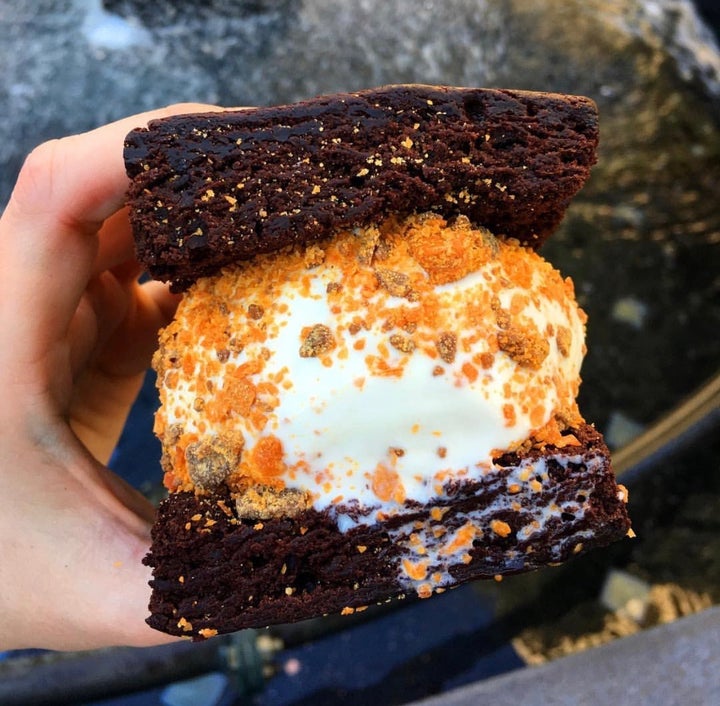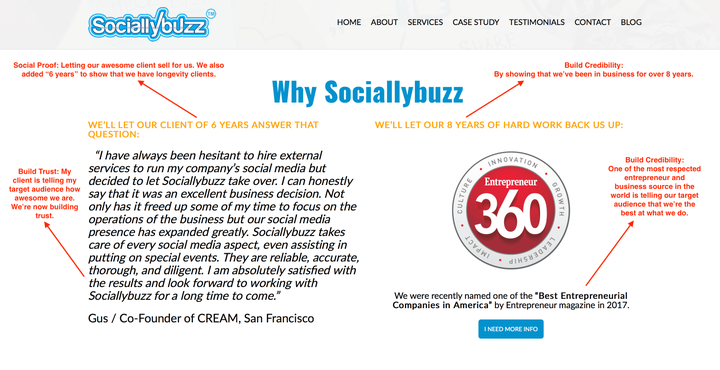Crush Your 2018 Marketing Goals With these Top 5 Social Media Tips!
There are so many Social Media Trends being predicted for 2018. If you were to read them all, you would walk around looking like this 😡, this 😱, this 🤬 or this 🤯. But because we like you 😍 and want to save you from banging your head against the wall, we created these top 5 social media tips that will help you crush your 2018 marketing goals. If you’re already a client of Sociallybuzz, then we already got you covered, but this is still a great article to read or share with your friends (show us some love). I always say an educated client is a great client. If you’re not a client (side note: we need to know why) and you want to grow your business to the next level in 2018, this article will be your very best resource to get you closer to your goals.
Without further ado, here are the top 5 Social Media Tips that will shape your business in 2018 and how to use them in your marketing efforts.
1. Create your own BGC
You’ve probably heard of the marketing buzzword "UGC" everywhere you turned in 2017 and even before. Short for user-generated content, UGC is the term used to describe any form of content such as photo, video, and other forms of media that were created by consumers on social media and is publicly available to other consumers. It has a specific feel to it that resonates with consumers. That feeling of “I could’ve taken that photo” and when that emotion is triggered, it converts into valuable engagement and even action. According to Adweek, Social media campaigns including user-generated content see 50% higher engagement. Consumers also find user-generated content to be much more influential, with 85% saying it has more of an impact on their opinion of a company than branded photos or videos.
Then you have professional content. Content that is normally developed in a studio with perfect lighting and staging for a brand. The content you might see on a website, marketing materials or in a TV commercial. Businesses learned very quickly in this new content-driven era that this type of content does not resonate with consumers like UGC on social media. It works better for some brands than others.
Now, what is a BGC? BGC is short for Brand-Generated Content and was officially coined by myself about 6 years ago (Yes, you now know someone that created a marketing buzzword). It is the love child of a UGC and Professional Content. Brand-generated content is any photo or video created by a brand with the intent to capture the “I could have taken that photo” feeling with their consumers. Because once a customer feels that, then it's easy for them to build a connection with that brand. Whether it's them seeing themselves wearing the product or eating that ice cream. BGC looks similar to UGC and gives the same feeling that resonates with the emotion that triggers meaningful action, but was actually created by the brand. Since brands can never predict when they will receive high-quality UGC to share on their social media channels, they should generate their own content to create a more refined content strategy.

BGC will become a major part of every brand and marketing agency 2018 and beyond social media strategy. It helps them to tell their story more strategically, evoke consumer emotions, and is just as influential as UGC.
A few steps to follow when creating your own BGC:
- Create individualized content based on the social media platform
- Appeal to emotion
- Be relatable and give your audience a reason to share your content
Need a Free Content Calendar? Download it here:
2. Be aware of FAKE influencers
Influencers and content creators are the hottest social media marketing craze right now. An Influencer is anyone with a large following on social media platforms like Instagram, Facebook, Youtube or Snapchat. They normally post cool, sometimes funny and relatable content. They are now even broken down to micro-influencers, people with a smaller following but can still be influential. On the other hand, Influential Content Creators are similar to influencers but they spend more time developing custom viral content, tutorials, etc to share with their followers and fans.
Over the past few years, we’ve personally seen influencers blow up, and brands are paying top dollars to get their product in the hands of the most influential people on the planet. There is a very good reason why - Consumers feel more comfortable trying a new product or place if a fellow friend or trusted source were to recommend it. Especially if that source has a strong voice, large following and influence in the social community. This can lead to significant increase in sales.

In return, influencers are getting free products and thousands of dollars to post a product, eat at a restaurant or share their experience with a brand. And rightfully so, as these influencers are bringing value to brands in exponential waves.
But with those types of rewards, the bad side of this craze is exposed. Hundreds of so-called influencers buy their followers or do unethical things to amass a large following so they can also cash in on free products and free money. The sad part is a majority of the time brands don’t know the difference or what to look for to weed out the fake influencers.
With this huge concern from brands and the possibility of losing ad revenues from businesses willing to pay influencers than to run an ad, social platforms like Facebook and Instagram will be pressured to purge fake profiles or bots from their platform which in turn dramatically reduce the following from fake influencers.
But don’t get too worried, here are 3 core metrics the team at Sociallybuzz focuses on when selecting an influencer.
- Reach: how many people the influencer reaches.
- Resonance: the extent to which people are influenced.
- Relevance: how relevant the influencer is to your audience
In simple terms, when an influencer post any content, look at what percentage of their followers like, comment or engage with that content. Doing a quick scan of their social media profiles, from the content they post to the different types of people that are engaging with the content, you will quickly be able to weed out the fakers. If the majority of their content is from the same people or from profiles that have no profile image or no post on their own profile, chances are you should run the other way.
We enjoy working with real influencers and content creators. Because we understand the value, and most importantly it’s not only about what they can do for us, but what we can do to help them remain interesting and relevant to their audience.
3. Advertising is your friend
Incentivizing your customers to take action on your content was a simple way for small businesses with smaller ad budgets to stay relevant in customers newsfeed. Whether it was a Like or Comment to enter a contest. The thought behind this was, the more people engaged with your content, the better your reach and engagement. Because Facebook’s algorithm would recognize your brand as being relevant.
But on Dec 18th, 2017, Facebook confirmed it will be fighting Engagement Bait. Facebook will be penalizing brands that use “Engagement Bait” by demoting individual posts.

Now, if there are no incentives a small business can use to get their audience to engage and interact with their content, they will no longer be as relevant on Facebook. Businesses spent thousands of dollars to acquire their customers or potential consumers to like their page and developed a huge community of customers. Now those customers will no longer see their posts unless they spend ad dollars to increase awareness.
According to Facebook, they are doing this to foster more authentic engagement. Publishers and other businesses that use engagement bait tactics in their posts should expect their reach on these posts to decrease. Meanwhile, Pages that repeatedly share engagement bait posts will see more significant drops in reach. This might be a change on Facebook, but it will ultimately impact businesses on Instagram and other social media platforms.
Business owners should continue to focus on posting relevant and meaningful stories that do not use engagement bait tactics, in addition to allocating more money for advertising.
In the past, you could count on the following actions to drive engagement on social media (In this order):
- Having quality and relevant content
- Attention-grabbing headlines
- Social incentives - Like, Comment, etc.
Then if you had an ad budget, that would significantly increase the awareness and reach of your content. Running an ad was the icing on the cake.
Now, the roles have reversed. First, you need to have a defined marketing strategy with a significant ad budget, then second, you need to create relevant content and tell meaningful stories. Having a social media advertising budget is like having electricity and a phone for your business. You cannot operate without them. Having the right advertising plan can help you increase your social following, boost the reach of your organic posts and drive sales. Actually, marketing might be more important than electricity, because if you don’t have customers, you won’t have money to pay for electricity.
But don’t get me wrong, you still need to create amazing Brand-Generated Content, Curate the best UGC, write attention-grabbing copies and learn to tell your brand’s story in a fun, creative and strategic way to stay relevant to your customers.
You just need to invest as much time, resources and finance in your advertising, as you do your content. The end goal is not to only focus on social media contest to boost engagement but to also invest in quality content and advertising.
Since this change is still pretty new, we at Sociallybuzz will be testing other ways to still incentivized customers, while staying relevant and not crossing the engagement bait line.
4. Understanding the value of Social Proof
What is Social Proof? Social proof, also known as informational social influence, is a psychological phenomenon where people assume the actions of others reflect correct behavior for a given situation. This effect is prominent in ambiguous social situations where people are unable to determine the appropriate mode of behavior and is driven by the assumption that surrounding people possess more knowledge about the situation.
This comes in the form of positive comments on an ad or social media post with lots of likes, retweets, and other social shares. Even when shopping online, you look for the products with the most positive reviews. You’re essentially using other consumers experience to make a buying decision.
Don’t believe me? Remember the last time you saw an engaging content, news article or ad on Facebook and Instagram. What was the first thing you did before actually clicking the link? You read all the comments first. Those comments are so powerful, that it can single handily convince you to click or don’t click on that link. Based on how positive or negative the comments are. Same with buying online or offline, people use social proof to make important buying decisions.
In even simpler terms, consumers want to know that their family, friends, celebrities, experts or other consumers are already using that product or eating at that restaurant. Why do you think Facebook shows you “Recommended for you” posts that also shows which friends already like that post or brand. So powerful, that in December they started rolling out those features on Instagram as well.
In even simpler, simpler terms, testimonials, and reviews can also serve as social proof. Consumers want to go in with a sense of trust, and knowing that a friend already like or think positive of your business will make it easier to positively influence their buying decision.
Now that you’re aware of how effective social proof is, it’s the perfect time to implement it for your business.
Here is how we recently integrated social proof to our website. I’ll also break down each element.

5. How to effectively use Social Selling
What is Social Selling? According to Linkedin, Social selling is about leveraging your social network to find the right prospects, build trusted relationships, and ultimately, achieve your sales goals.
Cold calling doesn’t work anymore and people are more educated in what they want. 77% of B2B purchasers said that they would not even speak to a salesperson until they had done their own research. The salesperson approach is slowly dying and there is a shift to social selling. This sales technique enables better sales to lead generation and sales prospecting process and eliminates the need for cold calling. Building and maintaining relationships is easier within the network that you and your customer trust.
Linkedin, the leader in all business-to-business communication stated the following as the 4 Pillars of Social Selling:
1. Create a professional brand A strong professional brand shows you are an active participant in your industry. It leads to more inquiries from prospects. It also leads to more responses to your communications.
2. Focus on the right prospects Social selling enables you to find and connect with prospects more effectively than traditional sales.
3. Engage with insights Position yourself as a subject matter expert by sharing relevant industry content, commenting on news alerts, and building your professional brand. Over 62% of B2B buyers respond to salespersons that connect with relevant insights and opportunities.
4. Build trusted relationships Build trust with prospects by sharing your perspectives and helping provide relevant information to common pain points. Have genuine conversations and focus on the needs of the prospect first, selling second.
If you still don’t believe in the power of social selling, maybe these stats will convince you:
- 81% of buyers are more likely to engage with a strong professional brand
- 50% of buyers are less likely to engage if they aren’t the right person to contact about a new product/service
- 89% of buyers are less likely to engage if the product/service is not relevant to their company
- 90% of decision-makers never answer a cold call
- 55% of all buyers do their research by using social networks.
- 70% of B2B purchase decision makers use social media to help them decide
- 79% of salespeople who use social media as a selling tool outperform those who don’t.
Social selling should not be ignored in 2018. Customers are researching businesses using social networks before they make a decision. It’s time to develop your 2018 social selling strategy for your business.
Make sure you take advantage of these 5 Social Media Tips that will shape your business in 2018.
Let’s recap:
- Create more consistent and creative BGC
- Influencers are great to work with but be careful of the fakers
- You use electricity to run your business? You NEED social media and paid advertising to run your business
- Consumers follow other consumers, so get your best customers to talk great about you
- Build trust and credibility to improve sales
In this article, I covered the most relevant and effective tips that you can act on right now. Social Media Tips that will give you a positive return on investment and results you can see in the first 6 months of 2018. I purposely excluded trends like Augmented Reality and Chatbots from this article because you need to pay attention to these top 5 things at the core. Once you understand, implement and execute these 5 tips, then we can have a later conversation on Augmented Reality, Artificial Intelligence, Chatbots, Net neutrality, and Blockchain for businesses.
But for now, let's go crush 2018.
Article Resources and Stats: Hubspot, Linkedin, Salesforce, Facebook, Adweek, Wikipedia
